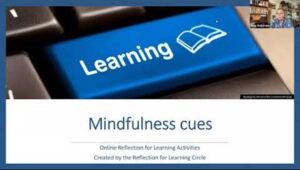by Dr Greg Walkerden, Honorary Senior Research Fellow, PhD, Macquarie University
This is the second post in the Reflection for learning develops metacognition series.
The aim of this series is to support educators and learners with their reflective practice as a foundational skill in developing metacognition.
The blogs in the series each focus on a different mode of reflection, with the aim of introducing a spectrum of approaches to reflective practice spanning analytical,
personalistic, critical, and creative. Each blog provides the scholarship underpinning the practice and shares a reflective activity to engage readers experientially.
There are many meaningful ways to engage with, and practice, reflection and a focus of this series is engaging the reader in a range of experiential activities.
The authors of this series are members of the Reflection for Learning circle. We have experimented, practiced and researched Reflection for Learning for over ten years.
The question
This post asks: “How do we shift to being deliberately mindful of our experience?”
Reflection and Metacognition
Mindfulness is a metacognitive practice with a very long history. In the written record, it goes back at least to the early Buddhist texts (Kabat-Zinn 2015), and, in the last 50 years, secular uses of being deliberately aware of our own experiencing have flourished (Harvey et al 2020).
At its heart, mindfulness is being aware of what we are experiencing as we are experiencing it, and aware of how we are acting as we act. Doing this deliberately might seem like quite a modest contribution to learning, since, in some ways, we are always aware of what we are experiencing and what we are doing. However, the wide variety of terms in English for being unmindful underline how helpful this shift can be: we may be distracted, tired, troubled, frustrated, disinterested, overwhelmed, burdened, weary, fuzzy, disoriented, anxious, inattentive, discouraged, upset, unmotivated, unnerved, uninterested, procrastinating, frazzled, and on and on.
Being open, attentive and sensitive is not something we can take for granted in ourselves or others. So ways of shifting deliberately to being mindful have a lot to contribute to many of the things we do, and specifically to reflecting on our practice, both as we are practicing – reflecting-in-action – and afterwards – reflecting-on-action (Schön 1987).
What does this look like in practice?
A very simple way of shifting into being mindful is to simply relax, pause, and do any of the following …
- think about something enjoyable, slowly, savoring it …
- quietly take in the sights and sounds of where you are …
- gently follow your own breathing … and if you drift off, gently return …
- take a little time to notice how you are feeling, particularly whatever is in the background (usually some amalgam, perhaps of curiosity, comfort, discomfort, doubt, ease, …) … let the background reveal itself …
In a teaching setting, the practice can be that when students hear the sound of a bell, or any other pre-arranged cue, they simply pause, relax, and spend a minute doing one of the above.
 Photo by petr sidorov on Unsplash
Photo by petr sidorov on Unsplash
As these instructions indicate, the heart of being deliberately mindful is pausing, relaxing, and then being aware gently, slowly, quietly – letting what is happening register. There is a great deal of empirical evidence – both in practice traditions and in the research literature – that mindfulness is a metacognitive practice that supports sensitivity, insight, and learning (Kabat-Zinn 2015, Harvey et al 2020). Such practices can be individual or shared.
How can I learn more?
For more detailed instructions for using this simple mindfulness practice in teaching, see our Mindfulness Cues video and the section ‘Mindfulness Cues’ in our guide (2020, p.34).
Two related mindfulness practices that explore mindfulness in nature and in movement are:
Both are very helpful in everyday life and in teaching.
References
Harvey, M., Lloyd K., McLachlan K., Semple A-L., & Walkerden, G. (2020). Reflection for learning: a scholarly practice guide for educators. AdvanceHE. (https://www.advance-he.ac.uk/knowledge-hub/reflection-learning-scholarly-practice-guide-educators)
Kabat-Zinn, J. (2015). Mindfulness. Mindfulness, 6, 1481–1483. https://doi.org/10.1007/s12671-015-0456-x
Schön, D. (1987). Educating the Reflective Practitioner. Jossey-Bass.
